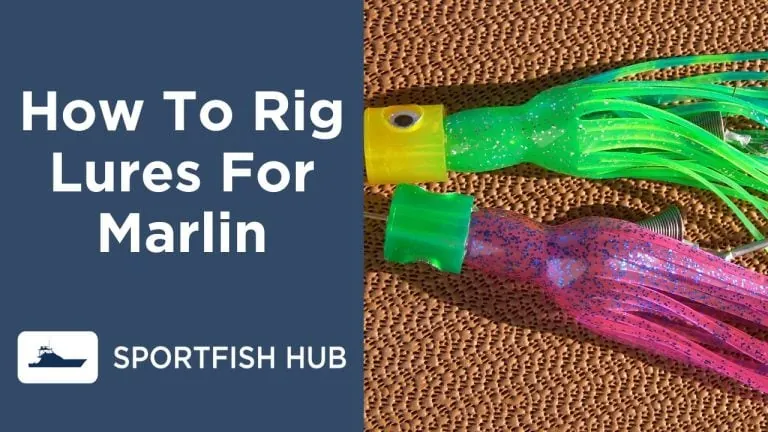Welcome to the world of marlin fishing, a sport that combines the thrill of the chase with the satisfaction of a successful catch.
One of the most critical aspects of this exciting sport is understanding how to rig your marlin lure effectively.
This comprehensive guide will provide you with detailed insights and step-by-step instructions on marlin lure hook rigging techniques. So, whether you’re a seasoned marlin angler or a beginner looking to improve your fishing expedition success, this guide is for you.
Table of Contents
- Understanding the Basics of Marlin Lure Hook Rigging
- Single-Hook vs. Double-Hook Rigging: A Detailed Comparison
- The Single Hook Swivel Rig: An Effective Alternative
- Step-by-Step Guide to Single-Hook Rigging
- Step-by-Step Guide to Double-Hook Rigging
- The Importance of Using a Fluorocarbon Leader
- Essential Rigging Materials and Tools
- Expert Tips for Successful Marlin Lure Hook Rigging
- Checking and Re-rigging Lures: A Crucial Step for Success
- Conclusion
Understanding the Basics of Marlin Lure Hook Rigging
Before we delve into the specifics, it’s essential to understand why proper marlin lure hook rigging is vital. Correct rigging ensures a higher hookup ratio, meaning more successful catches. It also helps prevent the loss of fish during the fight, making your fishing expedition more rewarding and ethical.
Moreover, proper rigging can significantly reduce the risk of injuring the fish, promoting ethical fishing practices. It also helps in maintaining the balance and swimming action of the lure, which is crucial in attracting marlins.
So, mastering the art of marlin lure hook rigging is not just about increasing your chances of a successful catch; it’s also about respecting the sport and the magnificent creatures that make it possible.
Single-Hook vs. Double-Hook Rigging: A Detailed Comparison
There are two primary methods of rigging marlin lures: single-hook and double-hook. Each has its advantages and considerations.
- Single-Hook Rigs: These are simpler and often preferred for their higher hookup ratio. They are easier to rig and manage, especially for beginners. However, they may not hold the fish as securely as double-hook rigs, making them less suitable for larger, more aggressive marlins.
- Double-Hook Rigs: These offer a better hold on the fish, making them ideal for larger marlins. They can be more challenging to set up and require more precision. However, their holding power makes them a popular choice among experienced anglers.
Understanding the differences between these two rigging methods is crucial for selecting the one that best suits your needs and skill level.
The Single Hook Swivel Rig: An Effective Alternative
In addition to the traditional single-hook and double-hook rigs, there’s another rigging method that’s gaining popularity among marlin anglers: the single-hook swivel rig. This rig is believed to provide a higher hook-up percentage and is safer than double hook rigs. The swivel rig allows the hook to ride ‘point up’ behind the lure, resulting in more hook-ups in the top or softer part of the fish’s mouth.
The single hook swivel rig is also easier to manage, making it a great option for beginners and those who prefer a simpler setup. However, it’s important to note that this rigging method requires a specific type of hook with a swivel, so make sure you have the right equipment before you start.
Step-by-Step Guide to Single-Hook Rigging
Now that we’ve covered the basics let’s dive into the practical part of our guide. Here’s a detailed, step-by-step guide on how to rig a marlin lure with a single hook:
- Select the Right Hook: Choose a hook size that matches your lure. A 9/0 or 10/0 hook is usually suitable for most marlin lures. The hook’s size and shape can significantly impact the lure’s swimming action, so choose wisely.
- Position the Hook: The hook should sit upright behind the lure. This position allows the water pressure to make the hook swim, increasing the hookup ratio naturally. The hook’s position can also affect the lure’s balance, so it’s crucial to get it right.
- Secure the Hook: Use a crimping tool to secure the hook to the leader. Make sure the crimp is tight and secure. A loose crimp can lead to a lost fish, so double-check your work.
Remember, the key to successful single-hook rigging is precision and attention to detail. Take your time to ensure everything is set up correctly, and don’t hesitate to make adjustments as needed.
Step-by-Step Guide to Double-Hook Rigging
Double-hook rigging is a bit more complex than single-hook rigging, but it offers a better hold on the fish, making it worth the extra effort. Here’s how to rig a marlin lure with a double hook:
- Choose the right Hooks: For double-hook rigs, select two hooks that are one size smaller than you would use for a single-hook rig. This ensures that the hooks don’t interfere with each other or the lure’s action.
- Position the Hooks: The hooks should be positioned so that one points up and the other points down. This positioning increases the chances of a successful hookup. It’s also essential to ensure that the hooks are evenly spaced and aligned with the lure’s centerline.
- Secure the Hooks: As with single-hook rigs, use a crimping tool to secure the hooks to the leader. Ensure that both hooks are firmly attached and that the leader is not twisted or kinked.
Remember, double-hook rigging requires more precision and skill than single-hook rigging. Don’t get discouraged if you don’t get it right the first time. With practice, you’ll be able to rig a double hook like a pro.
The Importance of Using a Fluorocarbon Leader
When it comes to marlin lure hook rigging, the type of leader you use can make a significant difference. One of the most recommended types of leaders for marlin fishing is fluorocarbon.
Fluorocarbon leaders have the same refractive index as water, making them nearly invisible to fish. This can give you a significant advantage, especially in clear water conditions. Fluorocarbon is also more abrasion-resistant than other types of leaders, making it more durable and reliable.
In addition, fluorocarbon doesn’t stretch as much as mono, which can improve your hook-up ratio. So, if you’re serious about marlin fishing, investing in a good-quality fluorocarbon leader is a must.
Essential Rigging Materials and Tools
To rig a marlin lure effectively, you’ll need a few essential materials and tools. Here’s a list of what you’ll need:
- Hooks: Choose hooks that are suitable for the size and type of your lure. As mentioned earlier, a 9/0 or 10/0 hook is usually suitable for most marlin lures.
- Leader Material: A fluorocarbon leader is highly recommended for marlin fishing due to its near invisibility in water and high abrasion resistance.
- Crimps: Crimps are used to secure the hook to the leader. Make sure to choose crimps that match the diameter of your leader material.
- Crimping Tool: A crimping tool is used to secure the crimps. A good crimping tool will have different size slots for different size crimps.
- Chafing Tube: This is used to protect the leader material from wear and tear. It’s especially important when you’re fishing for large, strong fish like marlins.
- Electrical Tape and Sharpie: These are used for marking and protecting your hooks.
Remember, the quality of your materials and tools can significantly impact your success in marlin fishing. Always opt for high-quality, durable materials and tools that can withstand the strength of a marlin.
Expert Tips for Successful Marlin Lure Hook Rigging
Now that you know the basics of marlin lure hook rigging, here are some expert tips to help you master this skill:
- Keep Your Hooks Sharp: A dull hook can significantly reduce your hookup ratio. Regularly check and sharpen your hooks to ensure they’re always ready for action.
- Use Electrical Tape and Sharpie on Hooks: Use electrical tape to prevent corrosion and a Sharpie to fill in the micro striations on the hook after sharpening. This helps to prevent rust and create a stronger hook point.
- Check and Re-rig Your Lures Regularly: Regularly check your lures for signs of wear and tear. If the leader material is frayed or the hook is dull, it’s time to re-rig.
- Practice Makes Perfect: Rigging is a skill that improves with practice. Spend time practicing your rigging techniques, and don’t get discouraged if you don’t get it right the first time.
Checking and Re-rigging Lures: A Crucial Step for Success
Regularly checking and re-rigging your lures is a crucial step for success in marlin fishing. Over time, the leader material can get frayed, and the hook can get dull. By regularly checking your lures, you can spot these issues early and re-rig your lures as needed. This not only increases your chances of a successful catch but also ensures the safety and ethical treatment of the fish.
Conclusion
Mastering marlin lure hook rigging is a crucial skill for any serious marlin angler. By understanding the basics, choosing the right materials and tools, and practicing regularly, you can significantly increase your success on the water. Remember, the key to successful marlin fishing is patience, practice, and the right rigging. So get out there, and happy fishing!












